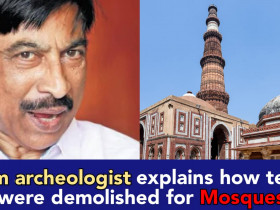No products in the cart.
Story of Rani Ahilyabai who rebuilt Banaras’ Kashi Vishwanath, when Aurangzeb destroyed it
Kashi Vishwanath Temple is one of the most prominent Hindu temples. The shrine is dedicated to Lord Shiva and located in Varanasi, Uttar Pradesh, India. Kashi is one of the most revered cities in India. It is believed to be one of the most ancient towns in India. If Kashi is at the heart of Hinduism, then Kashi Vishwanath Temple is the heartbeat of this goodly land.
The temple makes its place in the list of the twelve Jyotirlingas, the holiest of Shiva Temples. Varanasi city also used to be called Kashi in ancient times that is the reason this temple is popularly known as Kashi Vishwanath Temple.

A bad time came in 1669 CE when this temple was demolished by Aurangzeb, the sixth Mughal emperor who then built the Gyanvapi Mosque on its site. According to historians, Kasi Viswanath temple existed since many thousands of years. During Akbar’s reign, the temple was built by Raja Man Singh before the Mosque construction. The temple was destroyed with a view to warning to the anti-Mughal people and Hindu religious leaders.
In 1742, Maratha ruler Malhar Rao Holkar wanted to demolish the mosque and reconstruct the Vishweshwar temple at the site. However, he failed in his plan. Later, in 1780, his daughter-in-law Ahilyabai Holkar constructed the present Kasi Viswanath Temple adjacent to the mosque. Viswanath temple was believed to be destroyed by the army of Qutb-ud-din Aibak in 1194 CE when he defeated the Raja of Kannauj as a commander of Mohammad Ghori.
The shrine was rebuilt by a Gujarati merchant during the reign of Shamsuddin Iltumish (1211-1266 CE). It was demolished again during the rule of either Hussain Shah Sharqi (1447-1458) or Sikandar Lodhi (1489-1517). During Akbar’s reign, Raja Man Singh built the temple. However, orthodox Hindus protested against it as he had let the Mughal emperors marry within his family. Raja Todar Mal further re-built the temple with Akbar’s funding at its original site in 1585.
Even after Aurangazeb demolishing the original temple and constructing a mosque over it, the remains of the erstwhile temple can be seen in the foundation, the columns and at the rear part of the mosque. During 1833-1840 CE, the boundary of Gyanvapi Well, the ghats and other nearby temples were constructed.
In 1835, Maharaja Ranjit Singh of the Sikh Empire donated 1 tonne of gold for plating the temple’s dome. It is believed that when people received the news of Aurangazeb’s arrival to destroy the temple, the main priest of the temple jumped into the well and sacrificed their lives in order to protect the Jyothirlinga from invaders.
Later, it is believed that Shiva saved the priest from dying. The Linga is Swayambhu and it can’t be removed, so Shiva himself helped the priest in saving the Jyotirlinga.












